Welcome to the Top 10 Animals and Wildlife in the Rainforest.
There are various animals found in many regions on the planet. Some live in water; some live in dense forests; some live in snow areas and ice regions; some fly in the sky others crawl on the earth. Nature is full of various amazing animal species in many different regions.
And, of course, there are many animals and wildlife found in the rainforest!
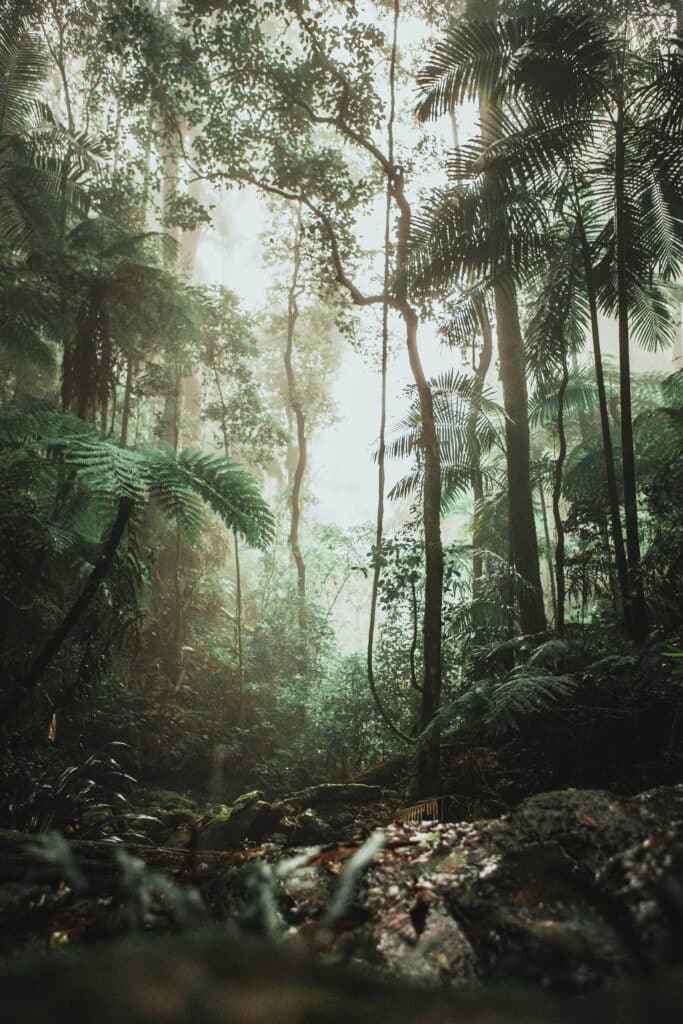
There are mammals like jaguars, howler monkeys, spider monkeys, and various reptiles found in rainforest regions like green anacondas,s, etc. Amphibians like frogs, red eye tree frogs, and dart frogs are also found in rainforests Birds like harpy eagles; macaws are also found in rainforests.
The rainforest on this planet covers almost 6 – 7 % of the land area.
Click below to jump through the list of the top 10 animals in the rainforest:
#1 King Vulture
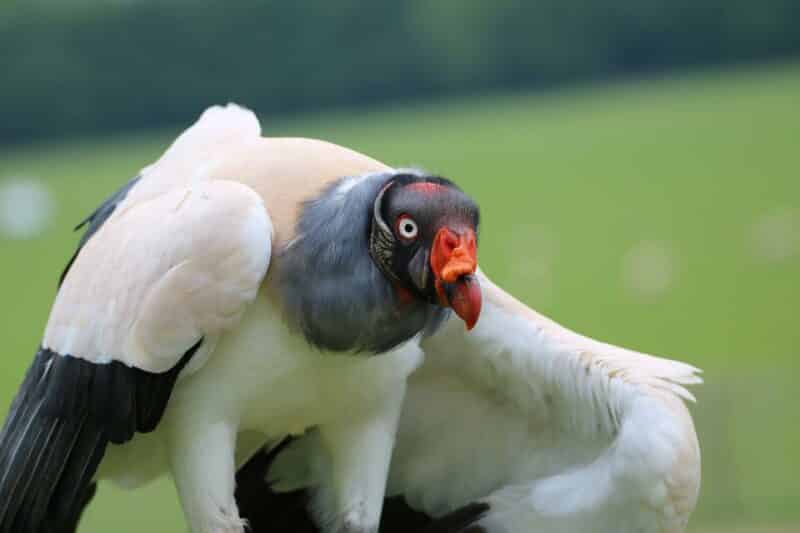
Scientific Name: The scientific name of the King Vulture is Sarcoramphus papa.
- Classification: The King Vulture belongs to the family Cathartidae, which comprises New World vultures. It’s one of the seven species in the New World vulture family.
- Size: King Vultures are large birds with wingspan ranging between 4 to 6.6 feet (1.2 to 2 meters) and weighing around 6 to 10 pounds (2.7 to 4.5 kilograms).
This vulture is one of the bigger types of vulture. It can develop to be 32 inches long. Dissimilar to different vultures, which are dull in variety, ruler vultures are smooth white with hazier tail highlights. The plumes around their heads and necks are blue, red, orange, and yellow. The skin hanging over their mouth, a wattle, is a radiant red-orange. Their noses are thick and solid, incredible for destroying tissue, and their long thick hooks are great for keeping a firm grasp on their supper. Earning themselves a spot on the top 10 animals in the rainforest list.
These enormous birds live in the highest parts of new shelter trees from Mexico to focal Argentina and Trinidad. They roost high up in these trees, giving them an extraordinary perspective on what is happening beneath them. They have a brilliant vision and depend on it to watch for different vultures that have spotted remains.
The Lord Vulture’s sense of smell isn’t that wonderful for different vultures. So they don’t necessarily, in all cases, use it to distinguish food. Whenever it sees that other scrounger birds have found a feast, they shoot down from the sky and push the others far removed. Every one of the different animal varieties of vultures rushes to clear out for the ruler. Like different scroungers, the lord vulture doesn’t kill its food. All things considered, it devours the cadavers and stays of creatures that have been killed by a few different means (known as carcasses).
#2 Electric Eel
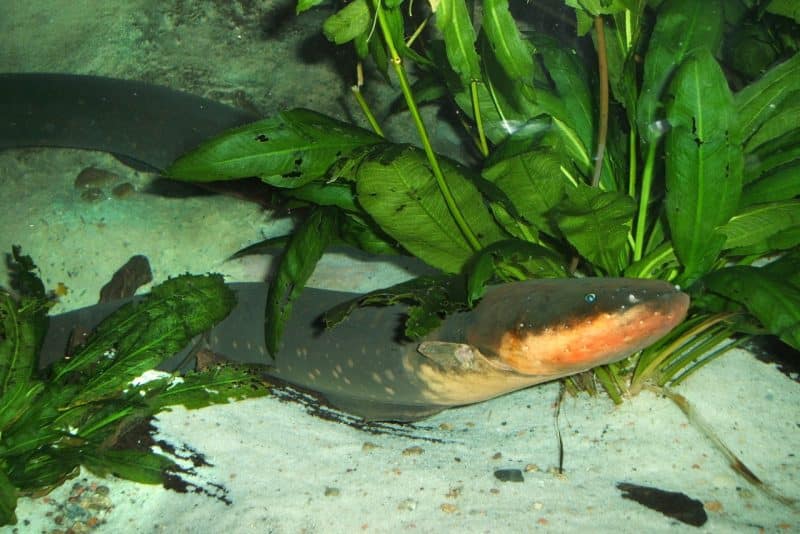
- Scientific Name and Classification: The Electric Eel’s scientific name is Electrophorus Electricus. It is not actually an eel but rather belongs to the knife fish family.
- Electricity Generation: Electric Eels are famous for their ability to generate electric shocks, which they use for hunting and self-defense. They can produce shocks of up to 600 volts and 1 ampere. This is achieved through specialized electric organs that comprise about 80% of their body.
- Distribution and Habitat: They are found in the freshwater habitats of the Amazon and Orinoco River basins in South America. They inhabit muddy bottoms in calm or stagnant waters, where they can hide and ambush prey.
Electric eels are merciless and can convey a monster electric arrival of around 600 volts, which is limitless. They make an electric release of 600 volts in light of 6000 electrolyte cells in the body. This quite a bit of electric release can cause a cardiovascular breakdown in a person. The eating routine of an electric eel is savage, using their shock to pursue any prey. Their total length can be more than 8 feet long.
They slant toward areas with new and tiny water. Still, the rising water levels in streams in South America can truly imperil them for attack utilizing land all around developed animals. Anyway, most “fun real factors” records arrange the electric eel with various eels; they are closer in their innate characteristics to carp and trick. This species is an evening with dreadful visual discernment.
The customary domain of the electric eel is exclusively freshwater locales, despite how they slant toward shady pools. These conditions are easily found in South America, but they are on a very basic level considered to be in focus and lower Amazon and Orinoco stream bowls. Anyway, it can live in many water profundities; they show up at the surface to breathe in the air under the anoxic waters. The electric eel isn’t endangered at this point, so no protection attempts are being made. Nearby individuals are asked to keep away from them and not get them to protect the area from intrusions.
#3 Poison Dart Frog
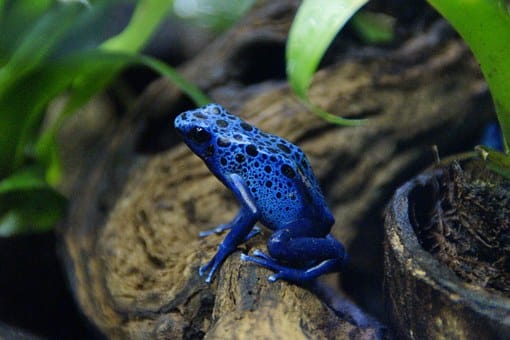
- Coloration and Toxicity: Poison dart frogs are renowned for their vibrant colors, ranging from bright yellow blue, red, or green. These colors serve as a warning to predators of their toxicity. Some species carry batrachotoxin, one of the most potent natural toxins known and can be fatal to predators.
- Distribution and Habitat: They are primarily found in Central and South American rainforests, living in humid environments. Their habitats range from terrestrial to arboreal, and they are often found near small bodies of water, which are crucial for their reproduction.
- Reproduction and Parental Care: Poison dart frogs have a unique reproductive strategy. After laying eggs on land, the male or female (depending on the species) will guard the eggs. Once the eggs hatch into tadpoles, one of the parents typically transports them on their back to small pools of water or water-filled bromeliads, where they continue to develop into frogs.
With a scope of brilliant tones — yellows, oranges, reds, greens, blues — poison dart frogs aren’t simply enormous hotshots by the same token. Those beautiful plans tell possible hunters, “I’m poisonous. Try not to eat me.” For instance, the brilliant toxin dart frog has sufficient toxin to kill 20,000 mice. Researchers imagine that toxin dart frogs get their harmfulness from some bugs they eat.
How do harm-shoot frogs catch their prey? With a long, tacky tongue that darts out and destroys the clueless bug! The frogs eat numerous little bugs, including natural product flies, subterranean insects, termites, youthful crickets, and minuscule scarabs, which researchers think might be answerable for the frogs’ poisonousness. Poison dart frogs live in the tropical jungles of Focal and South America. Most types of toxin dart frogs are little, once in a while under 1.5 cm in grown-up length, albeit a couple grows up to 6 cm long. No wonder they earn a spot on the top 10 animals in the rainforest list.
They weigh one oz. by and large. Most toxic substance dart frogs are brilliantly shaded, showing aposematic examples to caution likely hunters. Their splendid shading is related to their poisonousness and levels of alkaloids.
#4 Jesus Lizard

- Walking on Water: The Jesus Lizard, primarily the common basilisk (Basiliscus basiliscus), gets its nickname from its remarkable ability to run across water surfaces. This is achieved through rapid leg movements and specially designed toes on its hind feet that create air pockets, allowing it to stay momentarily above water.
- Distribution and Habitat: Jesus Lizards are native to Central and South America, ranging from southern Mexico to northwestern Colombia. They inhabit tropical rainforests and are commonly found near rivers, streams, and other bodies of water where they can utilize their water-running ability to escape predators.
- Diet and Lifestyle: They are omnivorous and have a varied diet that includes insects, small mammals, birds, and plant material. Jesus Lizards are excellent swimmers and climbers, and they often bask in the sun on tree branches or rocks near the water, which allows for a quick escape if threatened.
It is a type of reptile in the family Corytophanidae. The species is endemic to Focal America and South America, where it is found close to waterways and streams in rainforests. It is otherwise called the Jesus Christ reptile, Jesus reptile, South American Jesus reptile, or legato de Jesus Cristo for its capacity to run on the outer layer of water. The normal basilisk can be recognized from comparable species inside its reach by its huge size and the high balance-like peak along its back. Most normal basilisks are brown and cream in variety. Guys likewise have high peaks on the head and tail.
The two genders are brown to olive and have a white, cream, or yellow stripe on the upper lip and a subsequent stripe along one or the other side of the body; these stripes have higher differentiation in adolescents and blur as the age of the reptile. its eating regimen comprises bugs, for instance, scarabs or mythical serpent flies, blossoms, and little vertebrates like snakes, birds, eggs, and fish.
Hatchlings gauge a simple 2 grams and are 38 to 43 mm long. Adults can develop to a complete length (counting tail) of 76 cm Females are, for the most part, 135 to 194 g and weigh half as much as guys. The tail involves 70 to 75% of the all-out length: for instance, a 70-cm-long normal basilisk would have a 50-cm-long tail.
The normal basilisk has a huge mouth with saw-like teeth on the internal sides of the jaw. While the normal basilisk is generally known for its capacity to run on water, it is likewise a fantastic climber and swimmer and has been known to remain submerged for up to 30 minutes. The typical life expectancy is seven years in imprisonment; in the wild, it will generally be less a result of hunters.
#5 Leopard
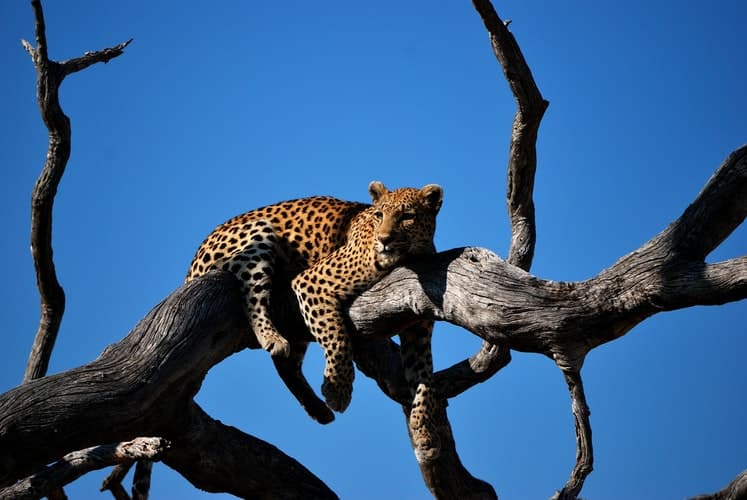
- Physical Attributes and Adaptations: Leopards (Panthera pardus) are large cats known for their beautiful spotted coats, which are made up of rosettes rather than true spots. They have a muscular build and are extremely versatile, with adaptations for both climbing and swimming. They can carry prey up into trees to avoid scavengers and can leap more than 20 feet horizontally.
- Distribution and Habitat Variety: Leopards have the most extensive range of any wild cat and are found in various parts of Africa and Asia. They inhabit a diverse range of environments including forests, grasslands, savannas, and mountainous regions. Their adaptability to different habitats is one reason for their wide distribution.
- Diet and Hunting Techniques: Leopards are carnivorous and have a varied diet including antelopes, monkeys, rodents, and birds. They are stealthy hunters and are known for their ability to stalk close to their prey before launching a rapid attack. Leopards often store their larger kills in trees to protect them from other predators and scavengers.
The leopard lives in three major get-togethers: females and their posterity, male “unions”, and particular folks. While females have a wandering presence searching for prey in enormous home scopes, folks are more fixed and may fairly spread out much more humble areas in locales with plentiful prey and permission to females.
The leopard is dynamic predominantly during the day, with tops during dawn and dusk. It benefits from little to medium-sized prey, generally weighing under 40 kg, and grades toward medium-sized ungulates like Impala, springbok, and Thomson’s gazelles.
The leopard usually follows its prey inside 60-70 m, charges toward it, trips it during the pursuit, and snacks its throat to stifle it irrationally. It breeds reliably. After hatching of right around 90 days, a litter of regularly three or four whelps is considered. Leopard whelps are significantly feeble against predation by other colossal carnivores like hyenas and lions. They are weaned at around four months and are independent by about 20 months mature enough.
Leopards are dynamic for the most part during the day, while various carnivores, for instance, pumas and lions, are dynamic basically around evening time. These greater carnivores can kill cheetahs and take their kills, thusly; the diurnal affinity of cheetahs helps them avoid greater trackers in districts where they are sympatric, similar to the Okavango Delta. No wonder it can be found on the top 10 animals in the rainforest.
In areas where the cheetah is the huge tracker (like farmlands in Botswana and Namibia), activity will in everyday addition around evening time. This may happen in especially dried regions, for instance, the Sahara, where daytime temperatures can reach 43 °C. The lunar cycle can affect the cheetah’s day-to-day plan — activity might augment on sundown nights as prey can be found at some point. Leopards can also jump very high.
But this goes with the gamble of encountering greater hunters. Hunting is a huge development throughout the day, with tops during first light and sunset. Get-togethers rest in rich clearings after dusk. Leopards habitually examine their region at insight centers, for instance, ascends to check for prey or greater carnivores; even while resting, they substitute at looking out.
You might also like Animals That Mate for Life or Awesome Underwater Animals.
#6 Howler Monkey
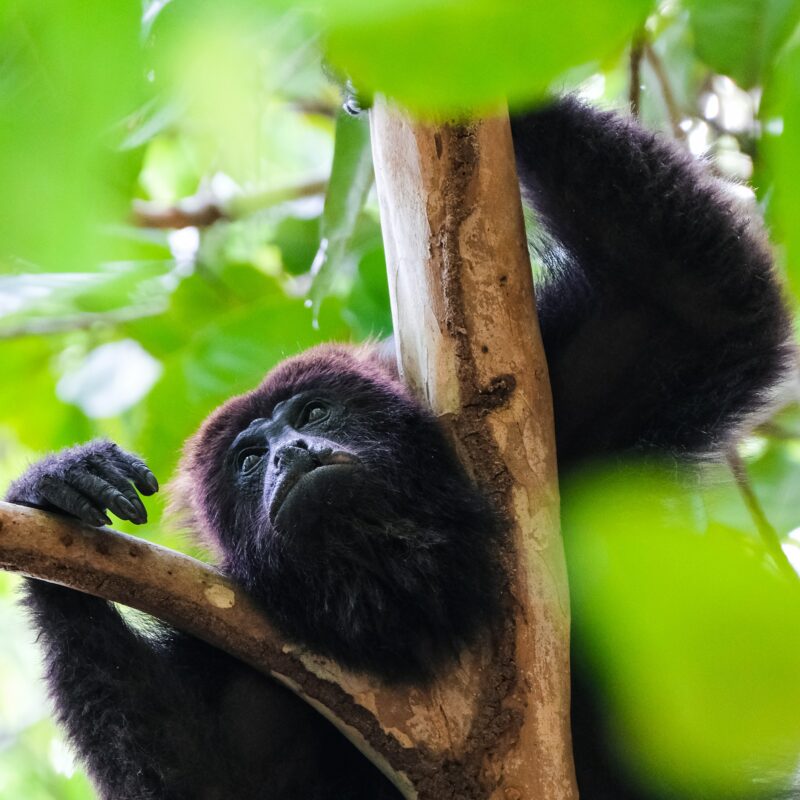
- Loud Calls: Howler Monkeys are famous for their loud vocalizations, which can be heard up to 3 miles (4.8 km) away. They use a specialized hyoid bone in their throat to amplify their calls, primarily for communication and territory defense.
- Distribution and Habitat: They are native to South and Central American rainforests, where they live in the tree canopies and are highly arboreal.
- Diet and Lifestyle: Howler Monkeys are primarily folivorous, eating mainly leaves, but they also consume fruits, flowers, and nuts. They live in social groups called troops and are known for their slow movements and lounging postures.
These are among the biggest of the New World monkeys. They are popular for their noisy wails, which can travel more than one mile through the thick tropical jungle. These monkeys are local to South and Focal American backwoods. Dangers incorporate human predation, living space annihilation, and catch for pets or zoo creatures. Fifteen species are perceived. Recently ordered in the family Cebidae, they are presently positioned in the family Atelidae.
Most howler species live in gatherings of six to 15 creatures, with one to three grown-up guys and numerous females. Mantled howler monkeys are an exemption, ordinarily living in gatherings of 15 to 20 people with multiple grown-up guys. The quantity of guys in a given gathering conversely corresponds with the size of their hyoids and is decidedly related to testicle size. This outcome in two particular gatherings, wherein one male with a bigger hyoid and more modest testicles has sexual intercourse solely with a gathering of females.
The other gathering has more guys, more modest hyoids, and bigger testicles, and free sexual intercourse happens among the gathering. In contrast to most New World monkeys, in which one sex stays in natal gatherings, adolescents of the two genders emigrate from their natal gatherings to such an extent that howler monkeys could spend most of their grown-up lives in relationship with inconsequential monkeys.
#7 Jaguar
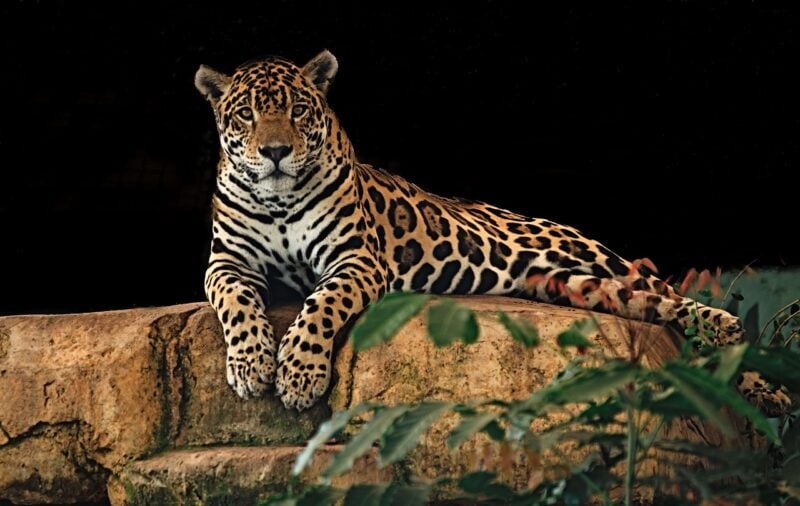
- Powerful Bite: Jaguars (Panthera onca) have an extremely powerful bite, capable of piercing through the skulls or shells of their prey. They are known for killing by biting directly through the skull between the ears of their prey, differentiating them from other big cats that go for the throat.
- Distribution and Habitat: They are native to the Americas, with their range extending from the Southwestern United States to Argentina. Jaguars predominantly inhabit rainforests, swamps, and grasslands.
- Solitary Hunters: Jaguars are solitary animals and are known for their stealth and strength in hunting. They have a varied diet including deer, capybara, peccaries, and sometimes even caimans and anacondas.
It is one of the endangered sorts of Amazon Rainforest Untamed life. The jaguar is the greatest feline in South America, and in the Amazon, there are, unfortunately, at this moment, various models. With a length (counting tail) of up to 2.5 meters, it checks as much as 120 kilos. He is a fair swimmer, has an evening penchant, and is a solitary animal. This is a colossal cat creature gathering and the super living person from the class Panthera neighborhood to the Americas. Finds itself on the top 10 animals in the rainforest list.
With a body length of up to 1.85 m and a heap of up to 96 kg, it is the greatest cat species in the Americas and the third greatest on Earth. Its undeniably stepped coat features light yellow to tan shaded fur covered by perceives that advancement to rosettes on the sides, yet a melanistic dim coat appears in specific individuals. The jaguar’s solid eat licenses it to pierce the carapaces of endless turtles and to use an amazing killing method: it snacks directly through the skull of mammalian prey between the ears to convey a destructive fiasco for the frontal cortex.
#8 Hoatzin

- Unique Digestive System: The Hoatzin (Opisthocomus hoazin), also known as the stinkbird, has a unique digestive system that ferments vegetation in an enlarged crop, similar to a cow’s stomach. This fermentation process produces a distinct, manure-like odor, earning it the nickname “stinkbird.”
Clawed Wings in Juveniles: Juvenile Hoatzins possess two claws on each wing, which they use for climbing trees. As they mature into adults, they lose these claws.
Distribution and Habitat: Hoatzins are found in the swamps, mangroves, and forests of the Amazon and Orinoco river basins in South America. They are primarily arboreal and are often seen clambering through vegetation in search of leaves, their main food source.
The hoatzin must probably be the most bizarre bird found in the Amazon. This bird seems to be a chicken with more than one stomach, much like a cow! That explains why it is sometimes known as the ‘Flying Cow.’ This dinosaur-like bird radiates a peculiar reptile-like scent and settles on a noisy decision. They are extremely cumbersome when they fly with their huge wings and little head. Its Latin name, Opisthocomus, comes from the plumes that once over its back.
They have a major paw on the finish of their wings that they use to safeguard themselves. Hoatzin chicks can stow away submerged to escape from hunters. However, grown-up birds can’t swim. Grown-ups can lay 4-5 blue spotted eggs all at once.
These bizarre-looking birds are, at times, killed for their meat and quills; however, they are not viewed as imperiled. Hoatzins are rigorously vegan, benefiting from plants, blossoms, and leafy foods normally found in large gatherings close to water bodies like bogs and mangroves. The hoatzin is the public bird of Guyana, a little country in northeastern South America. As expected, it is thus found on the top 10 animals in the rainforest list.
#9 Morpho Butterfly

- Iridescent Wings: Morpho butterflies are renowned for their large, iridescent blue wings. The striking blue color is not due to pigmentation but is a result of the microscopic structure of the scales on their wings, which reflect and refract light.
- Distribution and Habitat: They are primarily found in the rainforests of Central and South America, from Mexico to Colombia. They inhabit the thick, lower canopy of the forest but can often be seen flying in open areas near the forest edge.
- Diet and Lifecycle: Adult Morpho butterflies primarily feed on the juices of rotting fruits, and occasionally on tree sap or nectar. The lifecycle includes four stages: egg, larva (caterpillar), pupa (chrysalis), and adult. The caterpillars are herbivorous and feed on a variety of plant leaves.
These contain numerous types of Neotropical butterflies under the variety Morpho. This variety incorporates over 29 acknowledged species and 147 acknowledged subspecies, tracked down mostly in South America, Mexico, and Focal America. Their distinctive, radiant blue shading results from the minuscule scopes on the backs of their wings, which mirror light.
Then again, the underside of the morpho’s wings is a dull earthy-colored tone with numerous eyespots, giving disguise against hunters, for example, birds and bugs, when its wings are shut. Whenever the blue morpho flies, the differentiating dazzling blue and dull earthy colored colors streak, making it look like the morpho is showing up and vanishing.
The guys’ wings are more extensive than the female’s and have all the earmarks of being more brilliant in variety. Blue morphos, as different butterflies, likewise have two clubbed receiving wires, two front wings and two rear wings, six legs, and three body sections — the head, chest, and mid-region. Blue morphos live in the tropical backwoods of Latin America from Mexico to Colombia. Grown-ups invest the vast majority of their energy on the timberland floor and in the lower bushes and trees of the understory with their wings collapsed.
Be that as it may, while searching for mates, the blue morpho will fly through all layers of the timberland. People most regularly see morphos in clearings and along streams where their dazzling blue wings are generally apparent. The blue morpho’s whole life expectancy endures just 115 days, implying that most of their time is spent eating and imitating. The underside of the morpho’s wings is a dull earthy colored tone with numerous eyespots, giving disguise against hunters, for example, birds and bugs, when its wings are shut.
#10 Capybara
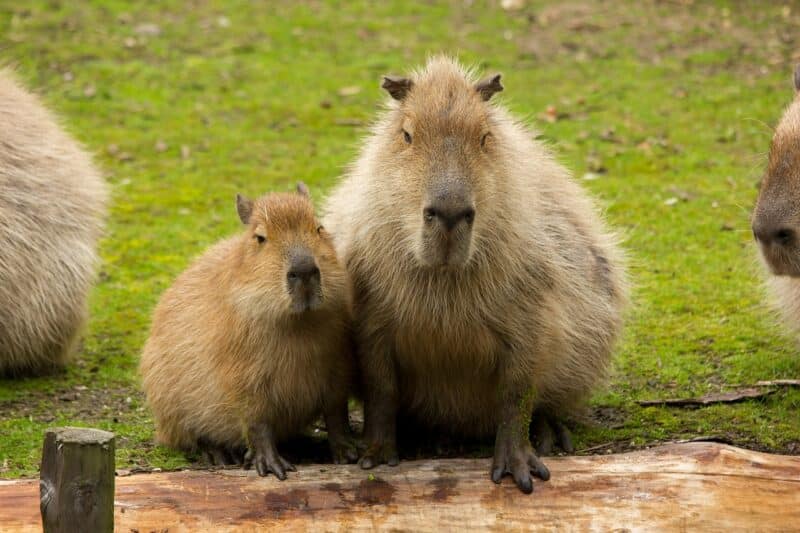
- Largest Rodent: The Capybara (Hydrochoerus hydrochaeris) holds the title for being the largest rodent in the world, weighing up to 145 pounds (66 kg) and measuring up to 4.3 feet (1.3 meters) in length.
- Semi-Aquatic Nature: Capybaras are semi-aquatic animals, spending a lot of time in water. They have webbed feet which make them excellent swimmers, and they can stay submerged for up to five minutes to hide from predators.
- Distribution and Social Behavior: Native to South America, Capybaras inhabit savannas and dense rainforests near bodies of water. They are highly social animals and usually live in groups ranging from 10 to 30 individuals, though larger groups have been observed. They have a varied diet, primarily eating grasses and aquatic plants.
They look like rats found in the local region of South America, and they are known as one of the biggest rats found on earth and belong to Hydrochoerus family. They look similar to guinea pigs and cavies found in rock. They also have close relations with other animal breeds like nutria, chinchilla, and agouti.
They live in savannahs and thick backwood and close to waterways. They are profoundly friendly animal varieties and live in bunches as extensive as 100 people; however, as a rule, lives in gatherings of around 10 to 20 capybaras. Capybara is used for many trading purposes. Their skin is used, and many use their meat for food. They have fatty skin, which is very thick.
It isn’t viewed as a compromised animal type. The capybara has a weighty, barrel-molded body and short head, with rosy earthy colored fur on the upper piece of the body that becomes yellowish-brown under. Its perspiration organs can be viewed as in the outer layer of the bushy bits of its skin, an uncommon characteristic among rodents.
The creature needs down hair, and its gatekeeper hair varies little from over hair. Capybaras are herbivores, munching mostly on grasses, oceanic plants, and products of the soil bark. They are extremely particular feeders and feed on the leaves of one animal group and dismissal different species encompassing it. They eat a more prominent assortment of plants during the dry season, as fewer plants are accessible.
List of Rainforest Animals
| Animal Type | Name | Description |
|---|---|---|
| Mammal | Jaguar | A large cat native to the Americas, known for its powerful bite and beautiful rosette-patterned coat. Predominantly found in rainforests. |
| Mammal | Capybara | The largest rodent in the world, native to South America. Semi-aquatic and found near bodies of water in rainforests and savannas. |
| Mammal | Howler Monkey | A primate known for its loud calls, native to South and Central American rainforests. Lives in the tree canopies and has a prehensile tail. |
| Bird | Hoatzin | Also known as the stinkbird, it has a unique digestive system that ferments vegetation. Found in the Amazon and Orinoco river basins. |
| Bird | Toucan | Known for its large, colorful beak, toucans are primarily frugivorous and live in the canopies of tropical rainforests in the Americas. |
| Reptile | Jesus Lizard | Named for its ability to run on water, it is native to Central and South America. Lives near rivers and streams in rainforests. |
| Reptile | Green Anaconda | One of the largest snakes in the world, found in the swamps and rivers of the Amazon rainforest in South America. |
| Amphibian | Poison Dart Frog | Small, brightly colored frogs known for the potent toxins they carry. Native to Central and South American rainforests. |
| Insect | Morpho Butterfly | Notable for its iridescent blue wings, Morpho butterflies are found in Central and South American rainforests. |
| Insect | Leafcutter Ant | Known for cutting leaves and carrying them back to their colonies, where they cultivate fungi on them for food. Common in rainforests. |
| Arachnid | Brazilian Wandering Spider | Considered one of the world’s most venomous spiders, it is native to South America and often found in rainforests. |
Frequently Asked Questions (FAQ)
One example of an animal that lives in a rainforest is the Howler Monkey, known for its loud calls and arboreal lifestyle.
It’s hard to determine the most common animal in a rainforest due to the immense biodiversity. However, in terms of sheer numbers, insects, particularly beetles and ants, could be considered among the most common.
Many animals live in the rainforest due to the abundance of resources, including diverse food sources and shelter. The warm, wet environment and the vast number of different habitats provided by the multi-layered structure of the rainforest also support a wide variety of species.
One animal that lives in the Amazon rainforest is the Jaguar, a large predatory cat renowned for its powerful bite and distinctive coat pattern.
Summary Top 10 Animals in the Rainforest
The rainforest is as diverse as it is beautiful. However, humans continue to impact nature negatively. As a result, many of the animals mentioned in this list are endangered and near threatened.
We hope to continue with conversation and sustainable tourism to see these beautiful places and their animals for generations to come.
If you enjoyed reading the above, check out Top 10 most endangered animals in India and Top 10 interesting facts about animals next!
- Animals and Wildlife in Colorado - April 24, 2024
- Best Places to see Sloths - April 24, 2024
- Where to See Alligators in the Wild - April 24, 2024


